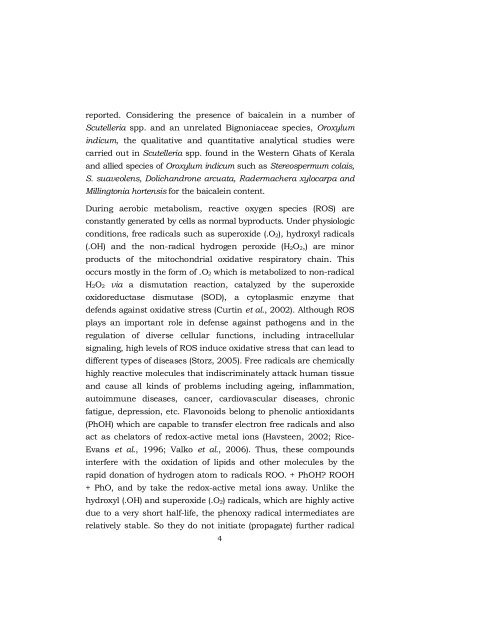Qualitative and quantitative analysis of biologically active principles ...
Qualitative and quantitative analysis of biologically active principles ...
Qualitative and quantitative analysis of biologically active principles ...
Create successful ePaper yourself
Turn your PDF publications into a flip-book with our unique Google optimized e-Paper software.
eported. Considering the presence <strong>of</strong> baicalein in a number <strong>of</strong><br />
Scutelleria spp. <strong>and</strong> an unrelated Bignoniaceae species, Oroxylum<br />
indicum, the qualitative <strong>and</strong> <strong>quantitative</strong> analytical studies were<br />
carried out in Scutelleria spp. found in the Western Ghats <strong>of</strong> Kerala<br />
<strong>and</strong> allied species <strong>of</strong> Oroxylum indicum such as Stereospermum colais,<br />
S. suaveolens, Dolich<strong>and</strong>rone arcuata, Radermachera xylocarpa <strong>and</strong><br />
Millingtonia hortensis for the baicalein content.<br />
During aerobic metabolism, re<strong>active</strong> oxygen species (ROS) are<br />
constantly generated by cells as normal byproducts. Under physiologic<br />
conditions, free radicals such as superoxide (.O 2), hydroxyl radicals<br />
(.OH) <strong>and</strong> the nonradical hydrogen peroxide (H 2O 2,) are minor<br />
products <strong>of</strong> the mitochondrial oxidative respiratory chain. This<br />
occurs mostly in the form <strong>of</strong> .O2 which is metabolized to nonradical<br />
H2O2<br />
via a dismutation reaction, catalyzed by the superoxide<br />
oxidoreductase dismutase (SOD), a cytoplasmic enzyme that<br />
defends against oxidative stress (Curtin et al., 2002). Although ROS<br />
plays an important role in defense against pathogens <strong>and</strong> in the<br />
regulation <strong>of</strong> diverse cellular functions, including intracellular<br />
signaling, high levels <strong>of</strong> ROS induce oxidative stress that can lead to<br />
different types <strong>of</strong> diseases (Storz, 2005). Free radicals are chemically<br />
highly re<strong>active</strong> molecules that indiscriminately attack human tissue<br />
<strong>and</strong> cause all kinds <strong>of</strong> problems including ageing, inflammation,<br />
autoimmune diseases, cancer, cardiovascular diseases, chronic<br />
fatigue, depression, etc. Flavonoids belong to phenolic antioxidants<br />
(PhOH) which are capable to transfer electron free radicals <strong>and</strong> also<br />
act as chelators <strong>of</strong> redox<strong>active</strong> metal ions (Havsteen, 2002; Rice<br />
Evans et al., 1996; Valko et al., 2006). Thus, these compounds<br />
interfere with the oxidation <strong>of</strong> lipids <strong>and</strong> other molecules by the<br />
rapid donation <strong>of</strong> hydrogen atom to radicals ROO. + PhOH? ROOH<br />
+ PhO, <strong>and</strong> by take the redox<strong>active</strong> metal ions away. Unlike the<br />
hydroxyl (.OH) <strong>and</strong> superoxide (.O2) radicals, which are highly <strong>active</strong><br />
due to a very short halflife, the phenoxy radical intermediates are<br />
relatively stable. So they do not initiate (propagate) further radical<br />
4

















